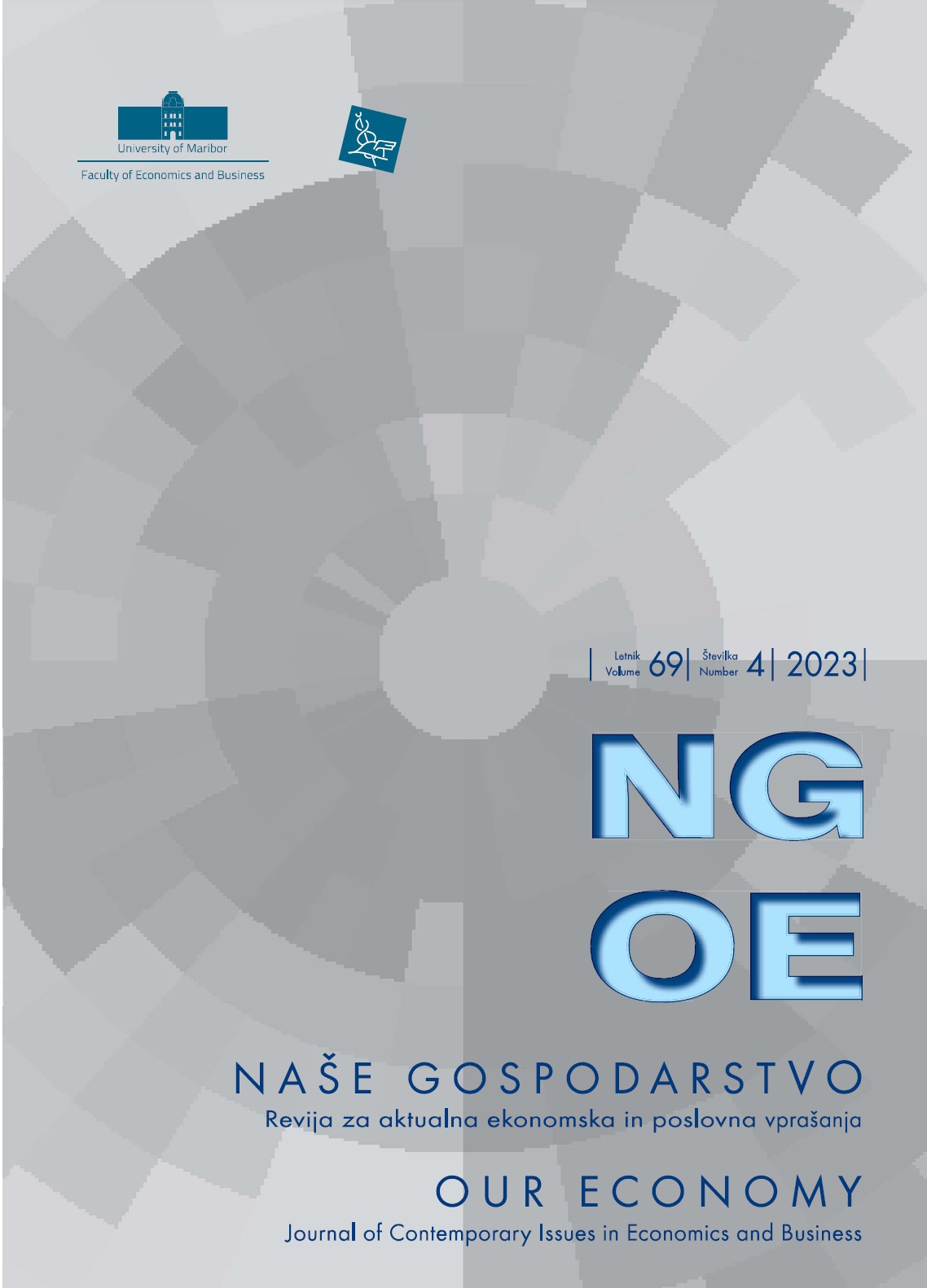Employees’ Entrepreneurial Work and Intention to Become Independent Entrepreneurs: A Comparison of India and Slovenia
Ključne besede:
Podjetniški nameni, Družbene razlike, Dinamične zmogljivosti, Indija, SlovenijaPovzetek
Employees' different levels of entrepreneurial work are likely to be associated with varying levels of knowledge and intentions in a country. This leads the current paper to argue how entrepreneurial work by employees influences employees' approach to running their businesses in India and Slovenia. Random samples of employees in India and Slovenia were surveyed from 2012 to 2019 by Global Entrepreneurship Monitor. The current study emphasized the significant role of entrepreneurial work by employees in their potential to become independent entrepreneurs, albeit with differences between India and Slovenia. Our main theoretical contribution is bridging the gap between dynamic capability and entrepreneurial work by employees at the macro level in India and Slovenia. Additionally, the study provides practical suggestions for Indian policymakers and Slovenian owners/managers
Prenosi
Literatura
Al Issa, H.-E. (2021). Psychological capital for success: the mediating role of entrepreneurial persistence and risk-taking. Journal of Entrepreneurship in Emerging Economies, 14(4), 525-548. DOI: https://doi.org/10.1108/JEEE-09-2020-0337
Al-Jubari, I., Hassan, A., & Liñán, F. (2019). Entrepreneurial intention among University students in Malaysia: integrating self-determination theory and the theory of planned behavior. International entrepreneurship and management journal, 15(4), 1323-1342. DOI: 10.1007/s11365-018-0529-0
Begley, T.M., & Tan, W. (2001). The socio-cultural environment for entrepreneurship: A comparison between East Asian and Anglo-Saxon countries. Journal of International Business Studies, 32(3), 537–553.DOI: https://doi.org/10.1057/palgrave.jibs.8490983
Bhide, A. (1994). How entrepreneurs craft strategies that work. Harvard Business Review, 72(2), 150-161.
Bosma, N., Stam, E., & Wennekers, S. (2012). Entrepreneurial employee activity: A large scale international study. Tjalling Koopmans Institute working paper 12–12. Utrecht: Utrecht University School of Economics.
Bosma, N., Wennekers, S., Guerrero, M., Amoros, J. E., Martiarena, A., & Singer, S. (2013). Special report on entrepreneurial employee activity. London: GEM Consortium.
Chan, K.-Y., Ho, M. R. H., Kennedy, J. C., Uy, M. A., Kang, B. N. Y., Chernyshenko, O. S., & Yu, K. Y. T. (2017). Who wants to be an intrapreneur? Relations between employees’ entrepreneurial, professional, and leadership career motivations and intrapreneurial motivation in organisations. Frontiers in Psychology, 8(1), 1–10. DOI: https://doi.org/10.3389/fpsyg.2017.02041
Cooper, A. C. (1985). The role of incubator organizations in the founding of growth-oriented firms. Journal of Business Venturing, 1(1), 75-86. DOI: https://doi.org/10.1016/0883-9026(85)90008-4
Covin, J. G., & Slevin, D. P. (1991). A conceptual model of entrepreneurship as firm behavior. Entrepreneurship theory and practice, 16(1), 7-26. DOI: https://doi.org/10.1177/104225879101600102
Dess, G. G., G. T. Lumpkin, & J. E. McGee. (1999). Linking corporate entrepreneurship to strategy, structure, and process: Suggested research. Entrepreneurship Theory and Practice, 23(3), 85-102. DOI: https://doi.org/10.1177/104225879902300306
Dheer, R.J.S. (2017). Cross-national differences in entrepreneurial activity: role of culture and institutional factors. Small Bus Econ, 48, 813–842. DOI: https://doi.org/10.1007/s11187-016-9816-8.
Ding, Z., Sun, S.L., & Au, K. (2014). Angel investors’ selection criteria: A comparative institutional perspective. Asia Pacific Journal of Management, 31(3), 705-731. DOI: https://doi.org/10.1007/s10490-014-9374-z
Foster, G.M. (1962). Traditional cultures and the impact of technological change. New York: Harper & Brothers.
Global Entrepreneurship Research Association (2019). GEM 2018/2019 Global Report. Retrieved from https://www.gemconsortium.org/file/open?fileId=50213
Hasan, K. K. (2021). The relationship between intellectual capital and organizational trust and its impact on achieving the requirements of entrepreneurship strategy (The case of Korek Telecom Company, Iraq). International Journal of Multicultural and Multireligious Understanding, 8(2), 130-146. DOI: https://doi.org/10.18415/ijmmu.v8i2.2405
Hellman, T. (2003). When do employees become entrepreneurs? Incentives, corporate strategy, and intellectual property rights. Working paper, Graduate School of Business, Stanford University, Stanford, CA.
Hellmann, T. (2007). When do employees become entrepreneurs?. Management Science, 53(6), 919-933. DOI: https://doi.org/10.1287/mnsc.1060.0648
Herbig, P., & Dunphy, S. (1998). Culture and innovation. Cross Cultural Management, 5(1), 13–21. DOI: https://doi.org/10.1108/13527609810796844
Herbig, P., & Jacobs, L. (1998). Culture as an explanatory variable for the Japanese innovative processes. Cross Cultural Management, 5(1), 3–28 DOI: https://doi.org/10.1108/13527609810796808
Hill, S., Ionescu-Somers, A., Coduras Martínez, A., Guerrero, M., Menipaz, E., Boutaleb, F., Zbierowski, P., Schøtt, T., Sahasranamam, S. and Shay, J., (2023). Global Entrepreneurship Monitor 2022/2023, Global Report: Adapting to a" New Normal". Retrieved from https://gemconsortium.org/file/open?fileId=51147
Hofstede, G. (1980). Culture and organizations. International studies of management & organization, 10(4), 15-41. DOI: https://doi.org/10.1080/00208825.1980.11656300
Inglehart, R. (2018). Culture shift in advanced industrial society. Princeton University Press.
Inglehart, R., & Welzel, C. (2010). The WVS cultural map of the world. World Values Survey. Retrieved from https://www.worldvaluessurvey.org/WVSContents.jsp?CMSID=Findings
Klofsten, M., Urbano, D., & Heaton, S. (2021). Managing intrapreneurial capabilities: An overview. Technovation, 99, 102177. DOI: https://doi.org/10.1016/j.technovation.2020.102177
Kuratko, D.F., & Hodgetts, R. (2004). Entrepreneurship, theory, practice. (6th ed.). London: Thomson/South-Western.
Leung, K., & White, S. (Eds) (2004). Handbook of Asian management. The Netherlands: Kluwer Academic Publishers.
Miles, R. & C. Snow. (1978). Organizational strategy, structure, and process. Englewood Cliffs, New Jersey: Prentice-Hall.
Miles, M. P., Paul, C. W., & Wilhite, A. (2003). Modelling corporate entrepreneurship as rent-seeking competition. Technovation, 23(5), 393-400. DOI: https://doi.org/10.1016/S0166-4972(02)00156-6
Miller, D. (1983). The Correlates of Entrepreneurship in Three Types of Firms. Management Science, 29, 770-791. DOI: https://doi.org/10.1287/mnsc.29.7.770
Padi, A., Ansah, W. O., Mahmoud, M. A., & Ntim, C. G. (2022). Corporate entrepreneurship and employees’ competencies: Do employees' perceived feasibility and desirability matter? Cogent Business & Management, 9 (1), 2102129. DOI: https://doi.org/10.1080/23311975.2022.2102129
Pandey, J., Sinha, D., & Bhawuk, D.P.S. (1996). Asian contributions to cross-cultural psychology. New Delhi: SAGE Publications Ltd.
Samsami, M. (2023). Business angels' ties with entrepreneurs in traditional and secular-rational societies: China, Egypt and Iran contrasted Germany and Norway. European Journal of International Management, 21(2), 234-255. DOI: https://doi.org/10.1504/EJIM.2023.133426
Prenosi
Objavljeno
Številka
Rubrika
Licenca
Avtorske pravice (c) 2023 Sahana Swaroop

To delo je licencirano pod Creative Commons Priznanje avtorstva-Nekomercialno-Brez predelav 4.0 mednarodno licenco.
